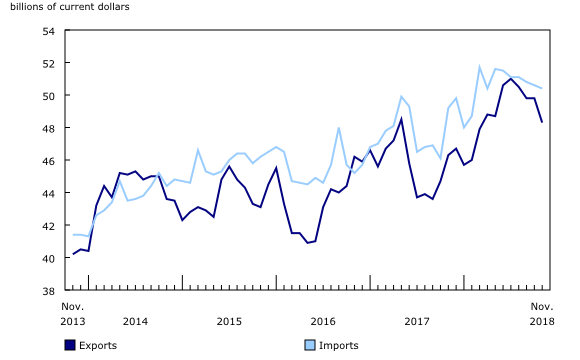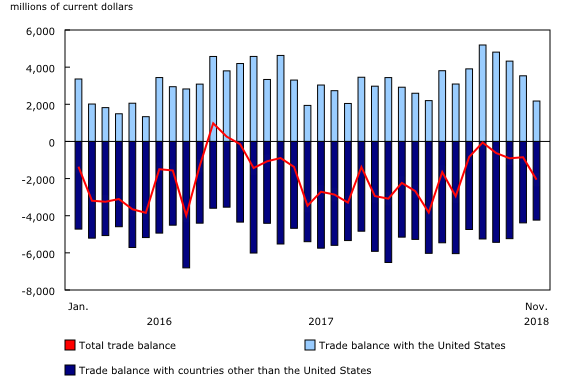Canadian international merchandise trade, November 2018
Archived Content
Information identified as archived is provided for reference, research or recordkeeping purposes. It is not subject to the Government of Canada Web Standards and has not been altered or updated since it was archived. Please "contact us" to request a format other than those available.
Released: 2019-01-08
Canadian exports fell 2.9% in November, mainly on lower crude oil exports, while imports decreased 0.5%. As a result, Canada's merchandise trade deficit with the world widened from $851 million in October to $2.1 billion in November.
Exports down for a fourth consecutive month
Total exports fell 2.9% to $48.3 billion in November, a fourth consecutive monthly decline. Export volumes were down 1.8% while prices fell 1.1%. Exports were down in 8 of 11 sections in November and, as was the case in October, energy products contributed the most to the decline. Exports excluding energy products decreased 1.4%.
Following a 6.7% decline in October, exports of energy products fell 9.2% to $8.4 billion in November. Crude oil exports (-17.7%) led the decrease, driven by a 13.9% drop in prices, which were down for a third consecutive month. Crude oil export volumes were down 4.4% in November. Lower exports of crude oil were partially offset by higher exports of coal to South Korea, China and Viet Nam.
Exports of basic and industrial chemical, plastic and rubber products also contributed to the decline, falling 7.5% to $2.8 billion in November. The decrease was driven by a 26.4% drop in exports of lubricants and other petroleum refinery products, mostly on lower exports of motor gasoline blending stock to the northeastern United States.
Exports of forestry products and building and packaging materials (-5.7%) were also down in November, primarily due to lower exports of pulp and paper (-10.1%). Despite the decline in November, the year-to-date cumulative value of pulp and paper exports was 18.2% higher compared with the same period a year earlier.
Imports of motor vehicles and parts on a downward trend
Total imports declined 0.5% to $50.4 billion in November. Imports were down in 7 of 11 product sections, led by motor vehicles and parts. Import volumes fell 0.3% and prices edged down 0.1%. Year over year, total nominal imports were up 2.4%.
Imports of motor vehicles and parts decreased 2.8% to $8.9 billion in November. Lower imports of passenger cars and light trucks, which fell 5.5% to $3.7 billion, were mainly responsible for the decline in November. This was the 9th decrease in 12 months, with imports of passenger cars and light trucks down 13.9% compared with November 2017. This decrease coincided with lower demand for new motor vehicles in Canada in recent months.
Imports of metal ores and non-metallic minerals fell 18.6% to $1.1 billion in November. Following a record high in September, imports of other metal ores and concentrates (-19.6%) were down for a second consecutive month in November, mainly on lower imports of gold for refining from the United States.
The overall decrease in November was largely offset by higher imports of aircraft and other transportation equipment and parts, which rose 21.2% to $2.1 billion. After reaching a five-year low in the third quarter of 2018, mainly due to a temporary slowdown in aircraft production in the United States, aircraft imports were up for a third consecutive month in November, mainly on the strength of higher imports of airliners.
Lower exports of crude oil to the United States
Exports to the United States fell 3.9% in November to $35.3 billion, mostly due to lower crude oil exports. Imports were down 0.3% to $33.2 billion. As a result, Canada's trade surplus with the United States narrowed from $3.5 billion in October to $2.2 billion in November, the smallest surplus since September 2017. Comparing the average monthly exchange rates, the Canadian dollar lost 1.1 US cents relative to the American dollar from October to November.
Imports from countries other than the United States fell 0.8% to $17.2 billion in November, a third consecutive monthly decline. Lower imports from Russia (crude oil), Switzerland (copper) and Mexico (passenger cars and light trucks) were partially offset by higher imports from China (computers) and Japan (gold and passenger cars).
Exports to countries other than the United States edged up 0.1% to $13.0 billion. A sharp increase in exports to the United Kingdom (gold) was almost entirely offset by lower exports to Hong Kong (gold), the Netherlands (iron ore and heavy fuel oil) and China (gold). As a result, Canada's trade deficit with countries other than the United States narrowed from $4.4 billion in October to $4.2 billion in November, the smallest deficit since December 2016.
Revisions to October exports and imports
Revisions reflect initial estimates being updated with or replaced by administrative and survey data as they become available, as well as amendments made for late documentation of high-value transactions. Exports in October, originally reported as $49.3 billion in last month's release, were revised to $49.8 billion, mainly on revised exports of crude oil. October imports, originally reported as $50.5 billion in last month's release, were revised to $50.6 billion in the current month's release.
Note on the partial US government shutdown
Under a 1990 agreement between Canada and the United States, each country uses the other's import data to produce statistics on its exports. On December 22, 2018, a partial shutdown of the US federal government came into effect, resulting in the closure of the United States Census Bureau.
For the duration of the shutdown, Statistics Canada will not receive data on Canadian exports to the United States. While this disruption does not affect data for the current release (November reference month), a continued shutdown could prevent Statistics Canada from publishing a complete picture of Canadian international merchandise trade statistics for the December 2018 reference period on February 5, 2019.
Statistics Canada will continue to monitor the situation and will provide further information to users as it becomes available.
Note to readers
Merchandise trade is one component of Canada's international balance of payments (BOP), which also includes trade in services, investment income, current transfers and capital and financial flows.
International trade data by commodity are available on both a BOP and a customs basis. International trade data by country are available on a customs basis for all countries and on a BOP basis for Canada's 27 principal trading partners (PTPs). The list of PTPs is based on their annual share of total merchandise trade—imports and exports—with Canada in 2012. BOP data are derived from customs data by making adjustments for factors such as valuation, coverage, timing and residency. These adjustments are made to conform to the concepts and definitions of the Canadian System of National Accounts.
For a conceptual analysis of BOP versus customs-based data, see "Balance of Payments trade in goods at Statistics Canada: Expanding geographic detail to 27 principal trading partners."
For more information on these and other macroeconomic concepts, see the Methodological Guide: Canadian System of Macroeconomic Accounts (13-607-X) and the User Guide: Canadian System of Macroeconomic Accounts (13-606-G).
Data in this release are on a BOP basis and are seasonally adjusted. Unless otherwise stated, values are expressed in nominal terms, or current dollars. References to prices are based on aggregate Paasche (current-weighted) price indexes (2007=100). Volumes, or constant dollars, are calculated using the Laspeyres formula (2007=100).
For information on seasonal adjustment, see Seasonally adjusted data – Frequently asked questions.
Revisions
In general, merchandise trade data are revised on an ongoing basis for each month of the current year. Current-year revisions are reflected in both the customs and BOP-based data.
The previous year's customs data are revised with the release of the January and February reference months, and then on a quarterly basis. The previous two years of customs-based data are revised annually and revisions are released in February with the December reference month.
The previous year's BOP-based data are revised with the release of the January, February, March and April reference months. To remain consistent with the Canadian System of Macroeconomic Accounts, revisions to BOP-based data for previous years are released annually in December with the October reference month.
Factors influencing revisions include the late receipt of import and export documentation, incorrect information on customs forms, replacement of estimates produced for the energy section with actual figures, changes in classification of merchandise based on more current information, and changes to seasonal adjustment factors.
For information on data revisions for crude oil and natural gas, see "Revisions to trade data for crude oil and natural gas."
Revised data are available in the appropriate tables.
Real-time data table
Real-time table 12-10-0120-01 will be updated on January 21, 2019.
Next release
Data on Canadian international merchandise trade for December 2018 will be released on February 5, 2019.
Products
Customs based data are now available in the Canadian International Merchandise Trade Database (65F0013X).
The updated Canada and the World Statistics Hub (13-609-X) is available online. This product illustrates the nature and extent of Canada's economic and financial relationship with the world using interactive graphs and tables. This product provides easy access to information on trade, investment, employment and travel between Canada and a number of countries, including the United States, the United Kingdom, Mexico, China, Japan, Belgium, Italy, the Netherlands and Spain.
Contact information
For more information, contact us (toll-free 1-800-263-1136; 514-283-8300; STATCAN.infostats-infostats.STATCAN@canada.ca).
To enquire about the concepts, methods or data quality of this release, contact Benoît Carrière (613-415-5305; benoit.carriere@canada.ca), International Accounts and Trade Division.
- Date modified:




